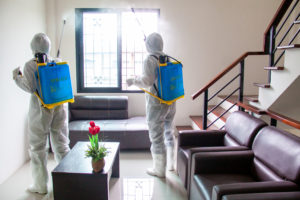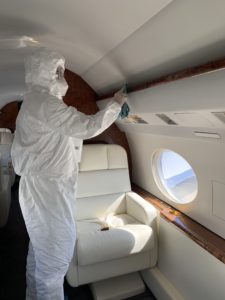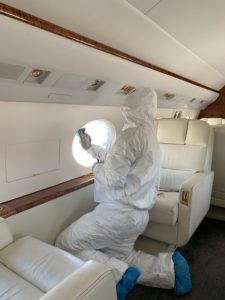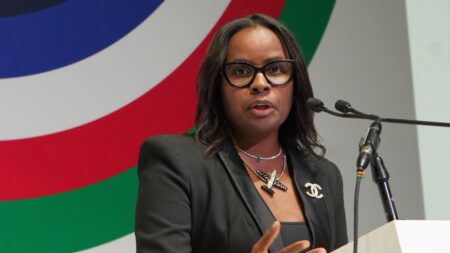Words by Paul Willis
FBOs and aircraft operators have quickly adopted new procedures and equipment to stay open during the pandemic.
As the air travel industry tries to pick up the pieces after the disastrous economic impact of the coronavirus pandemic, one of their key tasks is to reassure an anxious public that it is safe to use aircraft again.
This is an easier task for business aviation than commercial aviation, where the risk of virus transmission appears to be higher. “That is one of the beautiful things about private aviation,” says Ryan Waguespack, senior vice-president of the US National Air Transportation Association (NATA), a public policy group that represents the interests of general and business aviation in Washington. “Yes, you can go through the lobby but you don’t have to use the facility. You’re not locked into it in the way you are in a commercial air terminal.”
But while the transmission risk might be less, there is still a lot of understandable concern from private aviation travelers – especially in the early days of the pandemic.
Waguespack says, “We’ve had a lot of feedback from our members saying that their clientele is very concerned about the virus, asking how to ensure that flight operators and FBOs are doing everything they could to mitigate its spread.”
Standards

As a response to this feedback NATA’s safety committee has produced the Safety First Clean standard, a set of guidelines for FBOs on facility cleaning, disinfecting and facility operations in response to a pandemic. The guidance covers best practices for cleaning and disinfecting interiors, including high-touch surfaces, such as door knobs and point-of-sale keypads, and surfaces more susceptible to damage from conventional cleaning products, such as electronic devices and materials such as leather.
It also contains specific guidance for hygiene and cleaning protocols for different areas of the FBO, such as the lobby, pilot lounge and snooze rooms. Waguespack believes that fears of transmission in the early days of the pandemic led to air crews being denied access to these areas in some cases. “While most flight schedules fell off the cliff in mid-March there were still essential flights going on, such as air ambulance operations and repatriation flights,” says Waguespack. “But there was such a high level of fear we heard of situations where air ambulance crew couldn’t even go into the FBO to use the facilities.”
Situations like these arose because of a lack of guidance from the industry believes Waguespack. “It was really just about communication and getting standard operating procedures and best practices
out to the market to figure out how to engage,” he says.
FBOs can achieve the Safety First Clean standard through a process of self-certification. In the first two weeks after it was launched in mid-June the standard was adopted by 50 companies around the world, including in North America, Singapore and Australia.
NATA is not the only industry body or company to publish cleaning guidelines to help stop the spread of coronavirus. In late April digital operations and manual provider AviationManuals published a whitepaper updating FBO operations manuals in the light of the pandemic. The white paper contained guidance on cleaning best practice.
AviationManuals CEO Mark Baier says in crafting their guidance they adopted a safety management systems (SMS) approach which first assessed an operator’s risk level by looking at two variables: the likelihood of transmission and the severity of impact if transmission did occur.
Baier says, “We felt this way you can really take everything into consideration and from there determine what you should be doing and how cautious you should be. Major factors include your cleaning regime and the specific location that you’re operating in and out of, or the destination you are flying to.”
For operators judged low risk where there is “very minimal exposure to coronavirus” the white paper advises implementing basic cleaning procedures with more frequency, says Kevin Honan, AviationManuals senior advisor. For those in the medium- and high-risk categories deep cleaning using specialist cleaning and disinfectant products is advised.
Government guidelines

In putting together their guidance AviationManuals sourced information from documents published by aircraft manufacturers and by the US Centre for Disease Control (CDC). The CDC publishes a regularly updated list of products approved as disinfectants against Covid-19.
NATA also used the CDC guidelines to devise its own health and safety standard as well as soliciting the advice of cleaning companies specialized in cleaning FBOs and aircraft.
Business aviation company Clay Lacy Aviation were among the first companies to self-certify with the NATA standard. However, they did not wait until its publication before updating their cleaning protocols. The company created its own standard, known as CleanCheck, in April.
“We saw pretty early on that this wasn’t going to be a two or three month-long thing,” says Scott Cutshall, senior vice-president of business operations at Clay Lacy.
As part of their new protocols the company, which runs charters, aircraft maintenance and an FBO operation from its base at Van Nuys in Los Angeles, developed different cleaning regimes for their aircraft and ground operations.
The cleaning regimes for aircraft operations are more stringent reflecting the higher frequency of use and the challenges of maintaining social distance in a cabin environment. Besides protocols around the compulsory use of masks for air crews and travelers, the new standard also completely overhauled the protocols for food and beverage, says Dondi Pangalangan, Clay Lacy’s vice-president of flight operations.
“We don’t do any on-board food preparation at this time,” says Pangalangan. “All the food is pre-packaged and prepared in advance in an environment certified as
Covid-free.”
Before every flight the aircraft is deep cleaned and sanitized. Once the cleaning procedure is done the aircraft is locked and a seal is put on it.
“If that seal is broken for any reason that aircraft has to be re-cleaned and sanitized before any new passenger can be allowed on-board,” says Pangalangan. Once the flight has arrived at its destination “the aircrew will order a new cleaning through an approved vendor if one is available,” he says. However, “not all aircraft cleaning companies have the same tools at their disposal that we do”, so Pangalangan’s team ensures that each aircraft is equipped with a sanitization kit that the crew can use to clean the aircraft themselves.
Cleaning equipment

Among the specialist cleaning tools Clay Lacy use is a fogger that sprays the cabin interior with a disinfectant. A number of major US airlines including Delta, American Airlines and United Airlines have deployed foggers since early on in the outbreak.
The foggers have also been used to spray cabin surfaces with an anti-microbial barrier designed to kill pathogens. There have been various claims made about the efficacy of the anti-microbial coating the fogger’s release. Some manufacturers claim it protects surfaces for weeks while others say that it can work for up to a year. However, the self-cleaning nano-technology that the anti-microbial coating is composed of is as yet unproven in an aviation environment, says AviationManual’s Honan.
“We’ve seen operators actually avoiding those a little more and going more with what the manufacturer recommends, just because it’s not really certain yet whether those technologies might damage specific materials on the aircraft,” he says.
According to Honan, most operators have avoided using it because of concerns it may damage some aircraft surfaces.
Clay Lacy are also extremely vigilant about vetting cleaning products to ensure they don’t damage some of the more sensitive surfaces on the aircraft, such as leather upholstery or electronic screens. Pangalangan says, “We have to make sure the cleaning products work from an anti-viral perspective but also that we don’t do any damage to our owners’ property – after all, these aircraft are valuable multi-million dollar assets.”
It is also important to ensure that the products don’t corrode the flame retardant coating applied as a safety measure to aircraft interiors. Other cleaning products are ruled out because they are flammable and therefore cannot be transported on flights. “So when you take all this in to consideration it’s a very limited supply of products that we can use, compared to those suitable for cleaning a building or the inside of your car,” says Pangalangan.
Cleaning buildings
Clay Lacy has enhanced cleaning services for its ground operations, which at Van Nuys is composed of three facilities: a MRO facility, which has been fully-staffed during the outbreak, an administrative office which is also used as a hosting venue for FBO clients and a third facility for
base tenants.
“We have brought in an extra vendor for overnight cleaning and disinfection,” says Steve Lee, general manager of Clay Lacy’s Van Nuys FBO. “We’ve also asked all employees with personal offices to do their own sanitization and cleaning.”
These new cleaning regimes represent a paradigm shift in the health and safety protocols for business aviation, says Baier.
“It’s not business as usual, it’s not even just enhanced,” says Baier. “I think there’s a whole host of new products and cleaning methods that are being recommended during this time that weren’t standard previously.”
But tough times call for tough measures and business aviation is hurting. Clay Lacy, for example, saw a 94% percent drop in flight activity in April. Business has picked up steadily since then, but Cutshall doesn’t anticipate any major recovery to take hold until the latter part of this year, or early next year.
One of the most revealing questions is whether these new cleaning regimes will survive in a post-Covid world. Cutshall thinks it’s inevitable that they will: “This is a new standard within the company that will live on for years and years to come,” he says.





